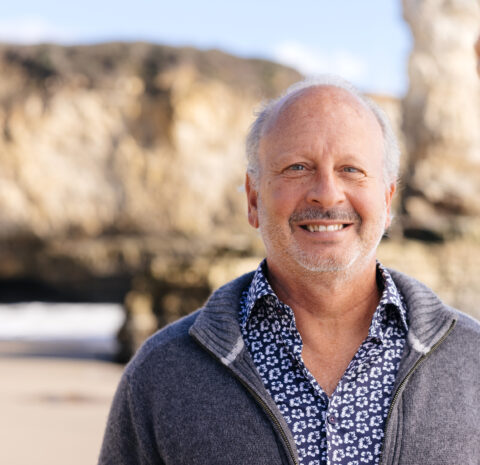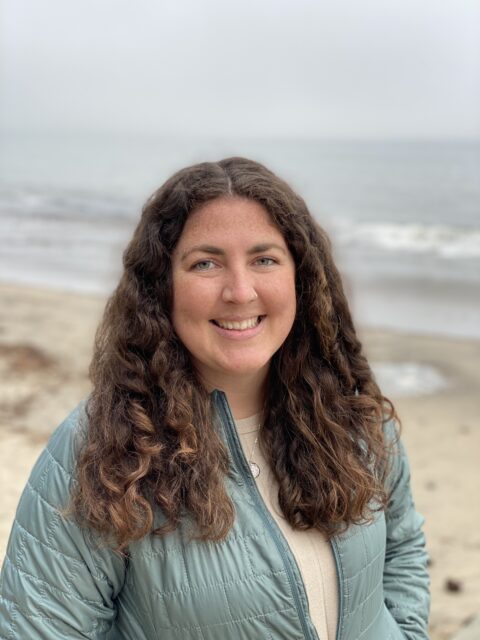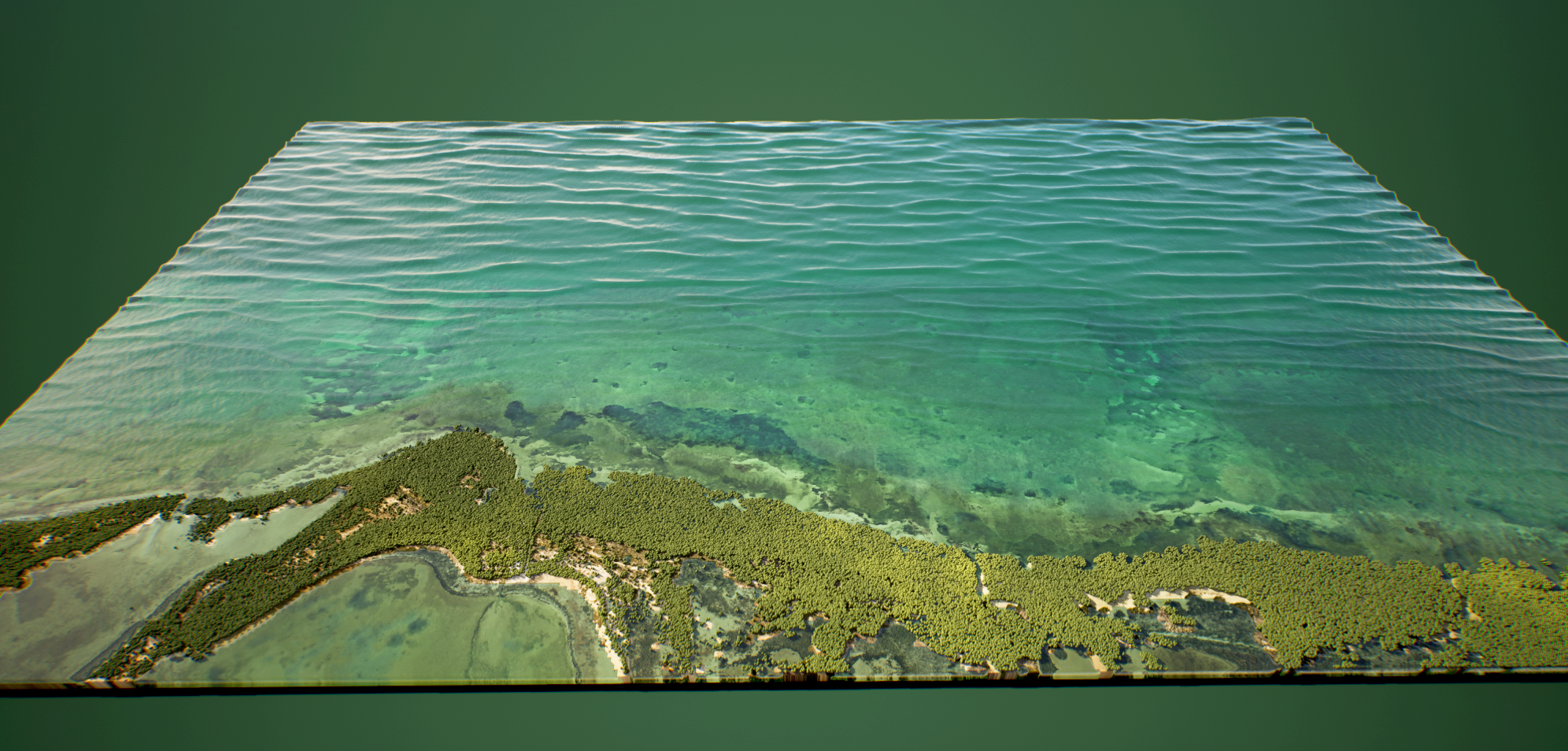Above: Coastal flooding model visualized in the game engine Unreal Engine 5 (model created by Ian Costello)
What’s in a word? When it comes to combating climate change’s impact on coastal regions, the answer, it turns out, is a lot.
To most of us, the word “infrastructure” conjures up images of public works—roads, bridges, dams, and harbors, for example. We don’t usually include the vast resources found in nature when we think of infrastructure.

Michael W. Beck, marine sciences professor, AXA Chairholder in Coastal Resilience, and director of the Center for Coastal Climate Resilience (photo by Elena Zhukova)
UCSC’s emerging Center for Coastal Climate Resilience is applying science to inform policy and practice. As an example of that work, “we are drafting policy that will recognize reefs and other coastal infrastructure as national natural infrastructure,” says Michael W. Beck, UCSC marine sciences professor and AXA Chairholder in Coastal Resilience, who was named the center’s director in November.
What can sound like “just a bunch of words,” Beck says, is actually incredibly high stakes.
“If our national infrastructure, like seawalls or telephone poles, gets damaged in storms, we invest in repairing it right away,” he says. “Our natural infrastructure is not considered national infrastructure, so we don’t reinvest in it when it suffers harm.”
The developing center represents the next step in the evolution of coastal resilience and sustainability work that’s been evolving on campus for the past decade, furthering ways scientific research can affect policy. The center will be growing rapidly to represent many lines of research and training on campus; the Coastal Science and Policy program and work in Beck’s Coastal Resilience Lab represent two early-focus initial cores of the center’s work.
Because of its location on Monterey Bay and its strength in coastal science research, “UCSC in particular can play an important role in determining coastal climate resilience and helping to identify solutions,” Beck says.
Noting the powerful and destructive winter storms that have pummeled California this winter, John MacMillan, interim vice chancellor for research and professor of chemistry and biochemistry, agrees.
“There is a real need for adaptation leadership to address flooding and erosion on California’s coasts,” MacMillan says. “Innovations in California could then be exported to rocky coasts worldwide.”
The center was seed-funded in 2022 with $20 million from the state of California and is working to secure more permanent funds for the future as its major areas of ongoing focus solidify.
It’s part of UC Santa Cruz’s acceleration of its research focus on climate change, resilience, and coastal sustainability, MacMillan says, adding that center leadership plans to engage public and private partners across communities, agencies, and businesses to advance the work.
Reef insurance
Beck points to a majority of infrastructure spending going into “gray infrastructure”—such as pipes, ditches, and retention ponds—rather than “building, restoring, and managing our natural infrastructure that protects us”—such as reefs and wetlands.
Redefining natural defenses such as reefs and wetlands as national infrastructure can ensure that money is directed toward repairing these natural resources rather than building reinforcements. In this vein, the center’s key projects fall “in the middle of economics, policy, and practice,” Beck explains, to address, mitigate, and repair climate-related coastline disasters.
Austen Stovall (M.S. ’22, coastal science and policy) was an associate specialist in the UCSC Coastal Resilience Lab who worked with the Nature Conservancy and the Federal Emergency Management Agency (FEMA) as part of her graduate thesis. Stovall took on the lead author role, Beck says, on the Coral Reef Restoration for Risk Reduction guide focusing on project design and proposal development.
The guide was requested by the U.S. Coral Reef Task Force, which is composed of FEMA, the Environmental Protection Agency, the Coast Guard, the Department of Defense, and a slew of other federal agencies.
Because Stovall did “such a great job” on the guide, Beck says, “it was approved, and the task force said, ‘Can you keep the band together and help us think about this policy to identify reefs as natural infrastructure?’”
Collaborative design
Beck’s team works “with a wide range of partners” including FEMA, the U.S. Geological Survey (USGS), the U.S. Army Corps of Engineers, and the National Oceanic and Atmospheric Administration (NOAA).
This kind of innovative and creative collaboration is a hallmark of UC Santa Cruz researchers, says Lori Kletzer, campus provost and executive vice chancellor.
“Consistent with UCSC’s well-established record of advancing impactful, interdisciplinary research, the Center for Coastal Climate Resilience opens opportunities for collaborations in research and creative scholarship across intellectual boundaries, universities and organizations, our state, the nation, and around the world in this vital work to build resilience to climate change along our coasts,” says Kletzer.
Beck has “worked very closely with some of our coastal-change scientists at the USGS Pacific Coastal and Marine Science Center [PCMSC] to advance our understanding of nature-based solutions in diverse coral and wetland systems,” says Peter Swarzenski, acting director of the PCMSC in Santa Cruz, which has been one of Beck’s key collaborators for the past 10 years.
The resulting “high-profile scientific papers,” Swarzenski says, “uniquely quantify how such natural habitats can directly save coastal communities’ dollars and lives.”
The Center for Coastal Climate Resilience has recently announced five new coastal climate resilience fellowships as part of the Coastal Science and Policy Program. It is “working on being able to vastly expand climate work in the interface between science and policy to better understand risks and where we can find solutions,” Beck says.
Social justice imperative
The new Center for Coastal Climate Resilience will include work in social justice, such as agroecology and food security in coastal ecosystems.
Beck’s lab has incorporated social vulnerability, not just economics, to identify where to invest in habitat conservation and restoration. One project demonstrated how conservation of mangroves—which provide fish, shellfish, and other inexpensive proteins, as well as coastal protection, erosion control, and more—protects vulnerable communities in the Philippines.
Beck and his team have also pinpointed “some of the most underserved populations” protected by coral reefs “in the United States territories—Puerto Rico, Guam, American Samoa,” he says. “We should be concentrating on reef protections for the most vulnerable communities.”
On that front, the center has issued two requests for campus proposals for which Beck expects to disburse approximately 25 seed grants at the $100,000 level, and a handful of “implementation grants,” up to a half million dollars.
Nature-based solutions

Austen Stovall (M.S. ’22, coastal science and policy), formerly an associate specialist in the Coastal Resilience Lab, is now a Knauss Fellow in Washington, D.C., working to advance marine policy in the U.S. (Photo by Erin Taylor)
The U.S. Defense Advanced Research Projects Agency (DARPA) recently announced a new Reefense program to design coral- and oyster-reef restoration projects to protect military installations. Beck notes that his group’s early reef work with collaborators at USGS and the University of Cantabria in Spain helped inspire efforts to use reefs for coastal protection.
“I was so happy with the idea that the Department of Defense is seeing that military installations could be protected by nature,” he says. “That was validating, and very exciting.”
Now, alongside a team led by the University of Miami, Beck and his collaborators are designing a reef-restoration project for Naval Air Station Key West.
Stovall is embarking on a new endeavor as a 2023 Knauss Fellow in Washington, D.C., where she will be a Legislative Fellow, working on a committee in the House or Senate for a year to advance marine policy in the U.S.
Beck’s work, Stovall says, provided her with tools and knowledge to implement in her new position. While it’s “bittersweet to leave the lab at such a pivotal time in growth and project realization,” Stovall notes that in her upcoming fellowship, she will take what she’s learned at UCSC and apply it to “creating actual policies on Capitol Hill.”
Visualizing with games
Graduate students such as Stovall, from four different divisions on campus—science, engineering, the arts, and social sciences—are involved in the center’s work, Beck says, “and we’ll be expanding that.”
The role of science and engineering may be immediately obvious even to the layperson, but what part do the arts play in a Center for Coastal Climate Resilience? Beck and his team “do all this risk modeling, but it is difficult for others to ‘see’ what we do,” he says. “If I tell you, ‘Well, you’re gonna lose some of those reefs and that is going to result in more flooding and erosion,’ I have no way of really showing that.”
Beck thought that they might be able to visualize the models with game engines.
That’s where Ian Costello, a digital arts and new media M.F.A. student (2024) who is specializing in experimental play, comes in.

Coastal flooding is simulated in this game engine model created by Ian Costello. (Image courtesy Ian Costello)
Breaking new ground in interdisciplinary learning and collaboration, Costello’s contributions simultaneously give a visceral sense of the true consequences of reef degradation and climate change, while also depicting solutions and their effects. The game engines are attached to fluid equations and real geography to demonstrate what’s at stake.
“Think about the graphics in a typical ‘shooter’ video game with a beach landing, and then envision those types of graphics, but being used to depict effects of climate change on flooding at the beach,” Beck says. “In the simulation, there are actually waves breaking, and those waves breaking are partly based on very simple but real wave equations. [Costello] works with these game engines, working with our team as we figure out how to incorporate the models we’re doing for the Department of Defense and its Reefense project.”
Seeing is believing

Ian Costello, a digital arts and new media M.F.A. student (2024) who is specializing in experimental play (photo by Carolyn Lagatutta)
Costello says that game engines are “fantastic tools for displaying coastal flooding scenarios in an easily interpretable visual format for viewers without specialized knowledge.”
The team pairs “the photorealistic detail offered by game engines with the precision and complexity of the flooding models that UCSC researchers are already using,” Costello explains. We work with “software that’s been developed for simulating fluid in games and films to generate compelling visuals that capture the wave breaking and flooding projected by more advanced models.”
With this technology, it becomes possible to see actual shorelines, which Beck demonstrates on his office computer, showing Naval Air Station Key West.
“We’re starting to model the waves that could be reduced with reef restoration at the base,” Beck says. “You can already see how flow changes around restored reefs and ‘bounces’ less at the shore. In our work, we have an opportunity to deploy the very latest, greatest visualization tools coming out of Silicon Valley.”
As Beck has emphasized all along, “Collaboration is at the heart of what we do.”
With the center in its early stage, more collaboration will be needed to secure long-term support of its work. This support will be essential to ensuring UC Santa Cruz’s ability to fulfill its intended impact in the critical area of coastal climate resilience.

